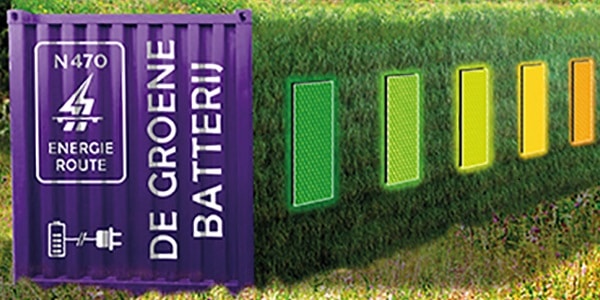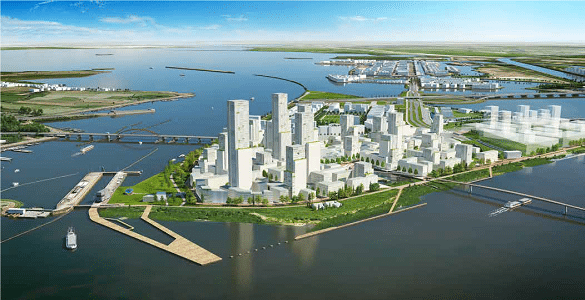
Sustainable Infrastructure Projects in the Netherlands
Table of contents
Where one city develops a new park with all types of vegetation, another constructs a road with sustainable ‘green’ asphalt. Sustainable infrastructure and green living environments have been on the agenda for a while, but we’re now truly taking off. Are you making your city or region greener? Or are you about to take the leap? Get inspired by these five sustainable infrastructure projects.
The Green Ship – Het Groene Schip
Afvalzorg and Markus BV have joined forces to create a natural barrier between the bustling Western Harbour District in Amsterdam and the green buffer zone of Spaarnwoude. The Green Ship Project is located in the Houtrakpolder, in the municipalities of Haarlemmerliede and Spaarnwoude.
A collaboration between Staatsbosbeheer (the Dutch Forestry Commission) and both towns, this remarkable design with an abundance of nature, cycling lanes and hiking trails on the North Sea Canal is bound to become an attraction for national and international tourists.
Since the start of the project in 2012, Afvalzorg has processed about 3 million cubic metres of secondary construction material. Impressively sustainable and incredibly green! Read more about this project on the Afvalzorg website.

The N470 Energises
While performing major maintenance works on motorway N470, the province of South Holland also seeks to improve the quality of the road itself. Perhaps this seems like nothing new, but this project is definitely a first for the province – for it is the first road that will be entirely carbon negative. So how does this work in practice?
Carbon negative roads may feature wooden bus shelters and crash barriers. Street lights that dim when traffic decreases also contribute to the green goal. New and more sustainable materials are applied for cycling lanes and asphalt, for example by using geopolymer instead of cement tiles or working with a new mixture of asphalt which is produced and processed at low temperatures. The latter has a flatter finish, reducing the rolling resistance of car tyres and the elasticity of the surface, which saves 2.5% on fuel consumption.
You can track Boskalis’ development through Instastories that will give you a unique peek behind the scenes.

Underground Waste Shipment System
The Amsterdam Sluisbuurt will become a unique corner of the city. The neighbourhood on Zeeburgereiland will feature a lot of high-rise, making for approximately 375 homes per hectare.
Both the pursuit of high-quality public space and the separation of waste are important parts of the project. With various national and local objectives in mind, the municipality of Amsterdam has been searching for a new way of waste collection, resulting in the project Ondergronds Afvaltransportsysteem (underground waste shipment system).
Going forward, international partner MariMatic from Finland will further elaborate its design. An innovative project worthy of close attention.

Sand Nourishment at Roggenplaat
Rijkswaterstaat, the Dutch national body governing the waterways, started preparations for sand nourishment at the Roggenplaat in the Eastern Scheldt in 2019, in collaboration with nature preservation organisation Natuurmonumenten and Wageningen Marine Research.
The nutrient-rich sandbank in the Eastern Scheldt is of great importance for migratory birds and seals. Due to the Eastern Scheldt storm surge barrier, the current has weakened, preventing the natural build-up of sandbanks. During storms, sand disappears from the banks into the adjacent channels. As a result, the Roggenplaat is getting lower and smaller, preventing birds from finding enough food and seals from resting.
As the job requires a meticulous approach, the area for sand nourishment was divided into seven sections. Rijkswaterstaat and Natuurmonumenten are fully committed to the replenishment of the sandbanks, which are so crucial to our nature. The Roggenplaat is of greater significance as well, as its presence softens the impact of waves, protecting the dikes on the southern end of the island of Schouwen-Duiveland. The sand nourishment is part of Project Smartsediment.

Nature Development at Leidsche Hoeve and N302 & N344 Ecoducts
Green projects are not limited to the waterfront. Various national and local authorities in the form of Rijkswaterstaat, Staatsbosbeheer, Kroondomein Het Loo, the municipality of Apeldoorn and the province of Gelderland are working together to connect various parts of natural area the Veluwe by establishing the world famous ecoducts.
The two new wildlife crossings Aardmansberg (N344) and Clemens Cornielje (N302) will connect the northern and southern parts of the Veluwe, allowing animals to cross safely. There are currently 10 wildlife corridors and a large number of smaller fauna corridors on the Veluwe. They promote biodiversity, which is good for our nature and for the Netherlands.
For more information about this green project, check out the website of the province of Gelderland and learn how these ecoducts got their names and what they stand for.
In Our Experience…
Sustainable projects can be found all over the Netherlands. And they are not just aimed at the protection of existing nature, but also at the construction of motorways, parks and urban objects. Sustainability can be achieved by using recycled materials, minimising waste or designing for carbon negative results. It is made possible by innovation of materials, machines and systems.
These fantastic developments will help to improve our living environment and our quality of life.
Alfamail supports these sustainable developments with project management software. Alfamail’s VISI software helps to structure and organise project communication between the client and the contractor. This allows the team to control time, costs and outstanding actions. No paperwork, but 100% digital.
Join the discussion on how to shape the future of sustainable product creation at the TECHNIA Software PLM Innovation Forum!


